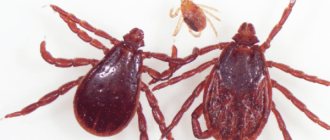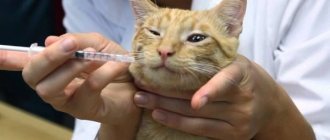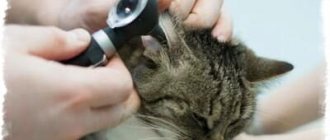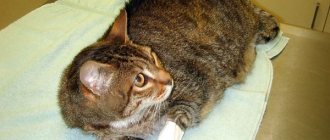How do you know if your cat has a fever?
You cannot tell if your cat has a high fever by a warm, dry nose, as many people believe.
The only way to know for sure whether it's a human or a cat is to take its temperature. Normal temperature in cats ranges from 38 to 39 degrees Celsius. Fever in cats occurs when the temperature rises above 39 C. While high temperatures can help fight the disease, temperatures above 41 C can damage internal organs. Contact your veterinarian immediately if your cat has a high fever.
Learn about the causes, signs and symptoms of high fever in cats, and what you need to know about taking your cat's temperature and caring for a sick cat.
Normal indicators
If a person's temperature is considered normal at 35.9 to 37.2 °C, then in a cat they are always higher - 38-39 degrees. There is an opinion that the normal temperature for representatives of hairless breeds is 42 °C.
In fact, for sphinxes it is the same as for long-haired cats. It's just that your pet's skin always feels hot when touched. It is not surprising, because there is no fur on it.
A slight increase in temperature in cats is always observed during the hot season. Indicators may vary throughout the day. So, during sleep and in the morning after waking up they are lower, but after physical activity, eating and in the late afternoon, on the contrary, they are increased. There's nothing wrong with that.
A temperature jump of 1 degree upward during estrus, pregnancy, childbirth, and also after sterilization or vaccination should not cause concern.
It should be noted that in kittens the mechanism of thermoregulation is formed gradually. In newborns, the readings are considered normal: 35.5 to 36.5 ℃; in babies 1-2 months old, they range from 38.5 to 39.5 degrees. Once the kittens reach 7 months of age, the indicators stabilize.
First aid at home before the doctor arrives
Until the doctor comes, you can alleviate your pet’s condition using the following measures:
- Calm and caress the cat, give it a light massage.
- Provide access to clean, fresh water. High temperature is a cause of dehydration. If your pet refuses to drink, force it to drink. A kitten's temperature can cause weakness, in which it will not be able to drink on its own - feed it with a syringe without a needle, often in small portions.
- Wrap the cat in a towel soaked in cold water and wrung out thoroughly.
- Apply ice wrapped in a towel to your inner thighs.
- Wrap your paws in gauze soaked in vodka.
- Place the pet's bed in a cooler place. Ventilate the room in which the animal is located.
Only after examining the animal can you give medications as prescribed by the doctor.
Causes of hyperthermia in cats
An increase in body temperature in a pet can be caused by a variety of reasons. The most common of them is ordinary overheating. If the cat has been in the sun or in a stuffy room for a long time, the readings can jump up to 41 degrees.
To stabilize the temperature, it is enough to place the animal in a cool room and give it water to drink. As a rule, after a couple of hours thermoregulation returns to normal.
Temperature can also rise significantly due to stress. Cats are emotional, and the appearance of another pet in the house, moving to a new place of residence, changing or losing an owner, even a banal trip by car to the veterinary clinic causes them great anxiety.
The animal's condition will stabilize as soon as it feels that it is not in danger and its loving owner is still nearby.
Hyperthermia can be triggered by infections. In such cases, the pet experiences symptoms such as diarrhea, vomiting, urinary retention, lack of appetite, and weight loss. Infectious diseases are very dangerous and require immediate attention to a veterinarian.
If a cat's fever is accompanied by sneezing, mucous discharge from the nose, and lacrimation, we are most likely talking about infection of the body with a virus. In such cases, it is also necessary to visit a veterinary hospital.
A high temperature can be caused by an inflammatory process occurring in the body, such as mastitis. There are often cases when impaired thermoregulation is a sign of cancer.
Signs of a fever in cats
The danger of an increase in temperature is as follows: serious metabolic and water-salt imbalances occur in the pet’s body, the brain does not receive enough oxygen, blood circulation is impaired, the animal may become dehydrated and have convulsive seizures.
Therefore, it is so important to detect a rise in your pet’s temperature in time in order to provide him with help. The following symptoms indicate this:
- loss of appetite or complete refusal of food. Cats even refuse their favorite treats;
- tachycardia and rapid breathing;
- chills;
- vomiting or diarrhea;
- apathy and lethargy;
- the animal hides in secluded corners, refuses to play with the owner;
- dry and very hot nose. A cat's nose may only be warm and dry when it wakes up, but it quickly becomes cool and moist.
All these are indirect signs indicating a possible increase in temperature. Without a thermometer, you still won’t be able to determine whether your cat has a fever.
How to measure a cat's temperature correctly
The four-legged pet's temperature should be measured rectally with a thermometer. There is no point in measuring under the foot, as the result will be incorrect.
Many owners prefer to use an electronic thermometer as it is the safest. A regular mercury thermometer will also work, but it is very fragile and therefore unsafe. Therefore, it is advisable for cat lovers without experience to resort to the first option.
It is rare that a cat will not resist when trying to measure its temperature, so it is advisable to carry out the procedure, which is painless but slightly unpleasant, together. One person will hold the animal, the second will perform the manipulation.
Measuring a cat's temperature:
- Place your pet on a hard, horizontal surface, tummy down.
- Lubricate the tip of the thermometer with Vaseline oil.
- Lift the cat's tail, carefully, twisting, insert the thermometer into the anus about 1 cm (for kittens - 0.5 cm).
- For accurate measurements, hold the thermometer for at least 5 minutes, regardless of whether it is mercury or electronic.
- After the procedure, wipe the thermometer with alcohol.
You can take your cat's temperature with an infrared ear thermometer. The procedure is absolutely safe and painless, in addition, the device will show the result in a maximum of 10 seconds. However, if an animal has an inflammatory process in its ear, the results will be unreliable.
Inexperienced pet owners prefer to determine the cat's temperature by looking at the nose: if it is wet and cool, then everything is in order with the pet's health. But if the nose is dry, then this indicates poor health, including a possible increase in temperature.
You should not rely on this method, because a cat that has just woken up from sleep will always have a dry earlobe. But you can touch the ears. If the cat's temperature is above 41 degrees, then they will be hot.
HOW TO HELP A CAT WITH A HIGH TEMPERATURE?
The health of a pet largely depends on its care and the conditions created for it. But no one is immune from the disease. Therefore, even with proper care and ideal conditions, a cat’s body temperature may rise, putting the animal into a depressed state.
Raising or lowering the animal's body temperature is to balance the formation of heat transfer. The circulation of heat transfer can be disrupted under the influence of internal and external factors: when the body overheats, when infectious agents enter the cat’s body, or even as a reaction to a stressful situation.
It is known that the normal temperature in cats is determined by the range from 37.5 to 39 degrees. In this case, in animals of one breed a certain body temperature will be considered normal, while in cats of another breed the same temperature will signal pathology. Kittens, as a rule, normally have a slightly higher body temperature than an adult cat. Any significant deviation from the norm in temperature indicators confirms that there are problems with the pet’s health.
Symptoms of fever in a cat
A change in body temperature, as is known, is a kind of reaction to pathological processes occurring in the body. There are external indirect signs by which one can determine that a cat is unhealthy and this is “signaled” by a rise in temperature.
Since the body is cooled through the animal's nasal passages, the animal's nose is normally slightly moist. The exception is the condition of the cat after waking up from sleep, when the nose remains dry. But in a healthy cat, after a few minutes, the nose becomes wet again. If your pet has a hot and dry nose while awake, this may be a sign that his body temperature has increased. A dry nose can also be observed in aging cats due to deterioration in the functioning of the glands, which is not a pathology and a cause for concern.
Sometimes an increase in temperature in a cat is accompanied by general weakness, rapid heavy breathing, and loss of appetite. Very high temperatures can cause your pet to shiver. Such symptoms, as a rule, indicate the infectious nature of hyperthermia, for which special treatment cannot be avoided.
Causes of fever in a pet
The dynamics of indicators that characterize a cat’s temperature is one of the most important signs of the presence or absence of any disease.
- An increase in temperature can be infectious in nature and can be caused by both pathogenic microbes and viruses, and parasites.
- Changes in thermoregulation are possible as a result of intoxication of the body.
- The cause of hyperthermia can be necrotic processes occurring in the cat’s body.
- A slight increase in temperature in cats may occur after prolonged exercise or during pregnancy.
Temperature measurement procedure
Some owners of furry pets, when they detect a high temperature based on external signs, panic because they have no idea how to measure it correctly. In principle, measuring the temperature of cats is not particularly difficult, since it is carried out with well-known medical devices, in particular a thermometer.
Ideally, you need to have an individual device for your pet, which is best stored in a special “cat first aid kit.” For measurements, you can use either a regular mercury thermometer or a more advanced type - an electronic thermometer.
Of course, an electronic device has a number of advantages. With its help, it is much more convenient and faster to perform the procedure, and the result indicators are highly accurate. However, in the absence of a universal device, a regular mercury thermometer is quite suitable. Before the procedure, it is important to treat it with any disinfectant solution. The same should be done after measuring the temperature.
You can accurately measure a cat's body temperature in the rectum, while securing the pet with a towel. This is done so that the animal does not move during the procedure, since the accuracy of the measurements is guaranteed only if the animal behaves calmly.
Before the procedure, the tip of the thermometer is lubricated with baby or any other fatty cream. Carefully lifting the pet's tail, lightly insert the tip of the thermometer into the anus to a depth of one or two centimeters. In just two or three minutes you can take out the device and see the result.
The easiest way to measure the temperature is if the cat is in a standing position. But it is possible to carry out this procedure even in the case of a lying position, when the animal is very weak due to illness. The cat is greatly influenced by the emotional state of the owner, so this procedure must be performed without unnecessary fuss.
How to help a cat with a high temperature?
Treatment methods for a cat with a high fever depend on the diagnosis and the extent of the disease. Since a high temperature can be a sign of a disease, the main treatment is aimed at eliminating the inflammatory focus in the body. Most often, when antibiotics are prescribed, the body temperature returns to normal.
In general, high temperature in itself is not dangerous. After all, with its help, the animal’s body tries to fight the virus on its own. Reducing the temperature with the help of antipyretic drugs is necessary in case of very high temperatures, which can provoke convulsions in the animal.
If the temperature is not very high, then you can try to bring it down at home. To do this, you need to moisten a towel or gauze with cold water and wrap the animal for about ten minutes. As the fabric dries, the cat's body temperature will noticeably decrease. Such manipulations are very effective in increasing body temperature from overheating of a pet outside in hot weather.
The same quick effect can be achieved by using ice from the refrigerator. Wrap the pieces of ice in gauze and place them on the cat's neck and inner thighs. In this case, you should give her something to drink more often. To prevent dehydration, it is recommended to give your pet pharmaceutical rehydron.
Only a specialist can prescribe comprehensive treatment for a cat after a thorough examination. If the temperature does not decrease even after taking antibiotics, the doctor will prescribe an additional study to identify the causes of hyperthermia.
It should be noted that a low temperature in an animal also indicates an existing pathology in the body. The cause of low temperature may be blood loss or hypothermia. Sometimes this temperature is observed in cats with chronic diseases of the kidneys and endocrine system. Help in these cases is to warm the pet using a warm heating pad. If your cat's body temperature persists for a long time, you should consult a specialist.
Since high temperature is a consequence of a disease, preventive measures are aimed at avoiding them by observing hygiene standards, rational nutrition and proper care of the animal.
If you think your pet is sick, contact a veterinary clinic in your city. You can find a list of clinics and doctors’ contact information in the “Veterinary Clinics” section.
Possible complications and their elimination
Hyperthermia does not always end with just a trip to the doctor. Sometimes it is fraught with serious consequences, various types of organ disorders. Heatstroke in cats leads to gastrointestinal disorders, disruption of the functioning of the cardiovascular, musculoskeletal, urinary, and nervous systems.
Healthy adults are able to recover on their own, but older cats, small kittens and animals with chronic diseases cannot cope. They need a thorough veterinary examination and treatment.
Even if the cat is apparently healthy, do not take risks and see a veterinarian. The consequences of heatstroke in cats can be fatal!
What to do if your cat has a low temperature
Hypothermia (low temperature) is no less dangerous for cats than fever.
A decrease in temperature is a signal of pathologies and problems in the cat’s body. The reasons for the sharp decrease may be such serious reasons: hypothermia, internal bleeding. Failure of the endocrine system, as well as diseases of the genitourinary system, can also manifest themselves as a low body temperature of the animal.
The critical temperature is 36.2-36.5°, it is life-threatening for cats.
This condition can develop after prolonged antibiotic therapy, severe dehydration of the body, as a consequence of toxic-infectious shock. If the temperature stays below 36.5 for more than two days, the animal may die. Therefore, it is so important to immediately take your pet to the clinic for intensive care.
First aid for low temperature:
- The cat needs to be warmed up. You can do this by covering it with heating pads filled with warm water.
- Wrap the animal in a warm blanket or blanket.
- Rub the animal's paws.
- Give warm drinks. If the cat refuses, you cannot force-feed it.
- Take your pet to a veterinarian to determine a diagnosis and prescribe a treatment regimen.
If a drop in temperature occurs in very elderly cats, it may be a symptom of impending death. You should consult a veterinarian so that he can suggest a course of further behavior with a dying animal.
Causes of fever in pets
When the body overheats and is stressed, the cat’s body temperature does not exceed 40 degrees. In most cases, the cause of fever can be a viral or bacterial infection that occurs in an acute form. The chronic course of pathologies is rarely accompanied by an increase in temperature. Disturbances in thermoregulation can be caused by toxins that accumulate in the body in the presence of parasites, protozoa and bacterial flora.
A cat's temperature often rises when there is a bacterial or viral infection.
The following diseases and pathological conditions contribute to an increase in temperature (hyperthermia):
- inflammatory pathologies of the ENT organs: otitis media;
- bronchitis;
- pneumonia;
- cystitis;
Processes of necrosis (death) of tissues in the body can also provoke an elevated temperature in an animal, so if there is a fever, it is necessary to show your pet to a veterinarian.
Symptomatic treatment
Before treating an animal, you need to measure its temperature using a regular thermometer. The best way is rectal measurement. You can also place a thermometer in the cat's ear.
It is difficult to help an animal on your own, because temperature is just a symptom. The pathology that caused the fever needs to be treated.
If, in addition to an increase in body temperature, there are other symptoms of a particular disease, the animal is shown to a specialist as soon as possible. Sometimes not only the health, but also the life of the animal depends on the efficiency of the owners’ actions.
If the diagnosis cannot be established, the veterinarian will prescribe antibacterial therapy for the animal.
When endocrine disorders become the cause of an increase in body temperature, a specialist will prescribe hormonal medications.
In some cases, emergency surgery may be required.
If the veterinarian suspects neoplasms, the animal will undergo an ultrasound scan and then choose a treatment strategy.
But there is no need to worry ahead of time.
For example, many infectious diseases do not require outside intervention - the animal’s body itself can cope with the disease perfectly well.
If the animal is overheated, you can apply ice to the cat’s inner thighs and neck, moisten the cat’s fur with warm water, and give it a drink.
To restore the water-salt balance in the cat’s body, you can give the animal a solution of Regidron. It is diluted in a ratio of 1 tsp. per liter of water at room temperature. It is difficult to persuade an animal to drink medicine, so the easiest way is to pour the solution into the cat’s mouth using a regular syringe without a needle (this must be done until the condition has stabilized).
If the temperature has increased as a result of nervous experiences, then you can drop soothing drops on the cat’s tongue.
Prevention
To prevent your pet from getting sick with viral and infectious diseases that provoke a rise in temperature, as well as many other unpleasant problems, you need to act according to the following scheme:
- Feed your animal correctly - the food should be nourishing, healthy and balanced; do not feed your cat from the table, as such food does not have any benefit for them.
- Vaccination - vaccinations and annual vaccinations can protect your animal from many dangerous ailments.
- Lack of self-walking - some animals are simply not created to live indoors, in which case they need to be trained to walk within the yard. This way, you will protect your pet from possible contact with other unvaccinated animals.
- Overheating - if you transport your animal in a car during the hot season, then do not leave it inside. You can’t imagine what kind of overload the cat’s body endures while you go to the store for 10 minutes.
Owners need to remember that temperature is a serious symptom that signals that not everything is ok with your pet’s condition. Under no circumstances resort to dubious methods of self-medication.
Animals are not able to help themselves in this state. Go to an appointment with a qualified veterinarian and only then can you be sure that your pet will definitely recover.
Reduced temperature
Hypothermia in a pet is also not a good thing. In most cases, this process occurs if the cat’s body feels weak due to a viral disease, and this is how immunosuppression manifests itself. Also, low temperature can be observed in pets who suffer from diseases of the kidneys, heart, endocrine and nervous systems. With hypothermia, the pet feels weak, depressed, does not eat or drink, and trembles. Pale mucous membranes and skin are also signs of the disease.
Stabilizing the temperature of cats
First aid for your beloved pet should be aimed at raising the temperature. To do this, it is necessary to cover the patient with hot water bottles. If this method does not help, you should take your pet to a veterinary clinic. Since your cat eats little or not at all during illness, give him something to drink.
What to do?
What to do if a cat has a fever and what measures should be taken first?
To begin, place the animal in the most comfortable place for it and do the following:
- Ventilate the room; the air in the room where the animal is located should be cool. Open the windows or turn on the air conditioner or fan.
- Give your cat a drink of Regidron solution if dehydration occurs.
- Cover your pet with a damp, cool towel.
- Offer your cat low-fat chicken broth.
- Do not wet your pet's fur - this creates a dense, impenetrable layer that interferes with normal thermoregulation.
- Provide your pet with peace.
Attention: the animal should not be forced to drink or eat. Forced drinking is only possible if the pet is dehydrated.
For what symptoms should you measure your temperature?
An elevated temperature may be indicated by hot ears, nose, and paw pads at rest, accompanied by dryness of the nose and redness of these areas. Its decrease, on the contrary, is accompanied by their unnatural coldness and pallor. If such changes occur, the temperature should be measured. Other indications for this procedure:
- copious and (or) purulent discharge from the mouth, eyes, ears, nose, anus, vagina, penis, sneezing, coughing are signs of infection;
- nausea, vomiting, diarrhea - symptoms of inflammation of the digestive system, helminth infestation, traumatic brain injury, overheating;
- pallor of the skin and mucous membranes – observed in anemia;
- convulsions, tremors (trembling of the paws, head, entire body), loss of consciousness - observed with a strong increase or decrease in temperature for various reasons, neurological or thermal damage;
- loss of appetite, weight loss, lethargy, apathy or, on the contrary, anxiety, agitation - can accompany most diseases.
Sometimes a veterinarian may prescribe daily temperature measurements to monitor the dynamics of the disease and monitor the effectiveness of treatment.
Content
- Normal body temperature in cats
- How to correctly measure a cat's temperature Contact measurement of a cat's temperature step by step
- The main reasons for the rise in temperature
- First aid for hyperthermia
How to determine temperature without a thermometer
Determining body temperature without a thermometer is always fraught with error. Note that tactile temperature determination does not provide enough data to suspect a lethargic state or fever in a cat. A critical decrease and increase in temperature are considered equally dangerous conditions.
On the cat's nose
Many owners believe that body temperature is determined by the nose. The cliché says: “a cold and wet nose means there is no temperature, a hot and dry nose means there is a temperature.”
- In fact, a cool, wet nose is normal when your cat is active.
- If your pet has slept in a warm place for a long time, a dry and warm nose will be considered normal.
- During a fever, your cat may have a hot and runny nose, which may indicate the development of a viral or infectious disease.
By the ears
The next reference point by which it is customary to determine temperature is the ears. The diagnostic method cannot be called accurate, but the data obtained by it is clearly closer to the truth than “nasal diagnosis”.
A cat's ears are covered with thin, sensitive skin without a layer of fat. Blood vessels lie directly under the skin, so tactile sensations provide fairly accurate data on body temperature.
Note! It's important to note that your ears may feel much hotter than their actual temperature. Ears may be cold with a fever if the cat is exhausted or dehydrated.
Along the armpits
The armpits and peritoneal area, provided there is no large amount of fur, also serve as indicators for determining temperature.
- To properly feel your body temperature, your hands need to be warm.
- The palms are placed on an open area of the body and held for several seconds.
- If your skin quickly adapts to body temperature, the temperature is most likely normal.
By mucous membranes
Mucous membranes are one of the most accurate landmarks for determining body temperature without a thermometer.
- At elevated temperatures, a cat's gums are hot to the touch, and their pigmentation becomes more intense (pink or even red).
- At low temperatures, the color of the gums fades to whitish, bluish, yellowish or gray (discolored). At the same time, the gums seem cold to the touch.











